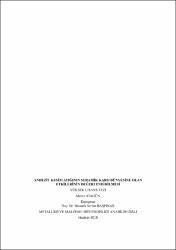| dc.contributor.advisor | Başpınar, Mustafa Serhat | |
| dc.contributor.author | Atagün, Merve | |
| dc.date.accessioned | 2019-10-30T07:36:43Z | |
| dc.date.available | 2019-10-30T07:36:43Z | |
| dc.date.issued | 2019 | en_US |
| dc.identifier.uri | https://hdl.handle.net/11630/7120 | |
| dc.description.abstract | Bu araştırmada, andezit kesim atıklarının granit massesinde kullanımı incelenmiştir. Andezit, nötr magmadan meydana gelmektedir. İnşaat sektöründe kullanımı çok fazla olan andezitler, kesim esnasında toz atık oluşturmaktadır. Bu toz atıklar hem atık depolama maliyeti düşünülerek hem de doğaya verebileceği zararlar göz önünde bulundurularak değerlendirilmiştir. Hammaddelerin kimyasal analizleri XRF cihazında tayin edilmiştir. Andezit kesim atıkları, granit karo massesinde feldspat görevi görecek şekilde sırasıyla %11.5, %21.5, %31.5 ve %41.5 oranlarında kullanılmıştır. Tüm numunelere pişirim küçülmesi, tortu analizi, yoğunluk tayini, renk ölçümleri, su emme ölçümü ve mukavemet ölçümleri testi uygulanmıştır. Numunelerin sinterleme davranışı ısıtıcılı mikroskop ile genleşme katsayıları ise optik dilatometre, minerolojik ve faz analizleri X-ışınları difraktometresi (XRD), mikroyapı incelemesi taramalı elektron mikroskobu (SEM) ile belirlenmiştir. Ortaya çıkan test sonuçlarıyla beraber, andezit kesim atıklarının seramik karo massesinde kullanımıyla beraber seramik karoların mekanik özelliklerde iyileşme görülmüştür. Bu sebeple seramik masselerinde alternatif bir hammadde olarak, seramik sektörüne kazandırılabileceği görülmüştür. | en_US |
| dc.description.abstract | In this research, the use of andesite cutting wastes in granite body was investigated. Andesite consists of neutral magma. Andesites, which are often used in the construction sector, generate dust waste during cutting. These dust wastes were evaluated considering both the cost of waste storage and the damages to nature. Chemical analyzes of raw materials were determined in XRF apparatus. Andesite cutting wastes were used as feldspar in granite tile bodies as 11.5%, 21.5%, 31.5% and 41.5% respectively. Firing shrinkage, sediment analysis, density determination, color measurements, water absorption measurement and resistance measurements were applied to all samples. The sintering behavior of the samples was determined by the microscope, the expansion coefficients by optical dilatometer mineralogical and phase analysis of samples were analyzed by X-ray diffraction (XRD), microstructure analysis were analyzed by Scanning electron microscope (SEM). With the results of the test, the mechanical properties of ceramic tiles were improved with the use of andesite cutting wastes in ceramic tile body. For this reason, it has been seen that ceramic bodies can be added to ceramic sector as an alternative raw material. | en_US |
| dc.language.iso | tur | en_US |
| dc.rights | info:eu-repo/semantics/openAccess | en_US |
| dc.subject | Andezit | en_US |
| dc.subject | Atık | en_US |
| dc.subject | Seramik Karo | en_US |
| dc.subject | Özellikler | en_US |
| dc.title | Andezit kesim atıklarının seramik bünyesine olan etkilerinin değerlendirilmesi | en_US |
| dc.title.alternative | Investigation on the effect of andesite cutting wastes on ceramic tile body | en_US |
| dc.type | masterThesis | en_US |
| dc.department | Mühendislik Fakültesi | en_US |
| dc.identifier.startpage | 1 | en_US |
| dc.identifier.endpage | 60 | en_US |
| dc.relation.publicationcategory | Tez | en_US |



















